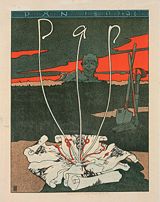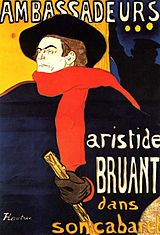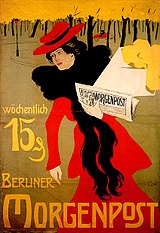Advertising art
Advertising art is based on the effective combination of advertising , art and typography with the aim of meeting artistic / aesthetic demands and at the same time encouraging customers to buy a product. Advertising art is a sophisticated form of commercial graphics . The quality of the print plays an important role in the implementation (see below technology). Today, advertising art in the form of posters , enamel signs, advertisements and packaging is an important collecting area, for which some museums also have extensive collections.
history

The beginnings of the art of advertising go back to the Middle Ages, soon after the invention of the art of printing. The labels or leaflets for the "miracle cures" of the hawkers, charlatans and quackers are often given as examples. The high cost of production and the compulsory guilds in the Middle Ages prevented further spread. With the invention of modern printing processes such as lithography at the end of the 18th century, new opportunities arose in the field of advertising graphics. However, even at that time, the promotion of goods in merchant circles was still considered unpleasant.
Until the middle of the 1890s there was no independent profession of " commercial graphic designer " in Germany . The advertisements were mainly created by draftsmen and lithographers using existing images. At the end of the 19th century the first tendencies to integrate artistic creation into the profane advertising machinery emerged. The Vienna Secession , founded in 1897, called for an association of visual artists: “We do not know any distinction between high art and small art, between art for the rich and art for the poor. Art is common property. ”The art of advertising experienced a high point in the period around 1910, the age of advancing industrialization, when both the spread and quality of the art of advertising reached a previously unattained (artistic) level.
Henri de Toulouse-Lautrec was one of the first and best-known artists to deal intensively with the design of advertising posters. Toulouse-Lautrec helped the art of advertising to achieve a high reputation, although by his untimely death in 1901 he only left around 30 advertising posters, some of which are among his most important works and are still very well known today.
In Germany, the works of advertising art are often based on the style of Art Deco , Art Nouveau and New Objectivity and for this reason have become coveted collector's items. The patrons in the economy promoted and used the creativity of the advertising artists - then for the benefit of customers and now for the pleasure of collectors.
Advertising studios
With the professional specialization of some artists in advertising, studios working exclusively for advertising emerged. In France, Jules Chéret's studio was one of the most important, in Germany the Hollerbaum & Schmidt art institute and Rudolf Mosse's studio should be mentioned. The Berlin-based art institute Hollerbaum & Schmidt, which employed advertising artists such as Lucian Bernhard , Hans Rudi Erdt and Julius Klinger , was one of the first studios to produce advertising posters and advertisements tailored to the product directly with clients. While previously so-called "blank posters" were predominantly used, which were produced in advance and whose image motif had no relation to the product, Hollerbaum & Schmidt achieved high popularity through the development of the so-called object poster, which aimed at an artistic claim while taking commercial interests into account optimal way.
The advertisements and posters designed by the artists usually bear the artist's signature or an explicit reference to the artist in the subtext.
Magazines important for the spread of the art of advertising

Die Jugend , a weekly magazine founded by Georg Hirth in 1896, used the artist poster on the title page for advertising purposes and contained a number of artistically designed advertisements on the inside. The youth in Germany contributed significantly to the spread of Art Nouveau in art.
The first edition of the satirical weekly magazine Simplicissimus also appeared in 1896. Since its inception, the advertising artist Thomas Theodor Heine has been one of the best-known and most frequently represented employees of this magazine. Other magazines worth mentioning in this context are Pan , Die Insel and Ver Sacrum .
Collectibles
- Posters
- Advertisements or advertisements
- Enamel signs
- Advertising stamps or vignettes
- Tin cans
- Collective pictures
technology
See also
literature
- J. Schmiedchen (ed.): New manual of advertising. 1st edition. Reinhold Wiechert, publishing house "Soll und haben", Berlin 1929.
- P. Friesenhahn, A. Schwering: Handbook of advertising. 3. Edition. Violet Verlag, Stuttgart 1911.
- J. Meißner (Ed.): Strategies of advertising art 1850-1933. German Historical Museum, Berlin 2004, ISBN 3-86102-130-7 .
- Michael Weisser (Ed.): German advertising. Doell Verlag, Bassum 2002, ISBN 3-88808-273-0 .
Web links
Individual evidence
- ^ The work of art of the month - October 2011. ( Memento from March 9, 2014 in the Internet Archive ) on: lwl.org


